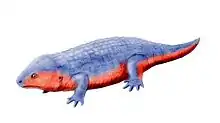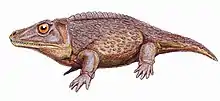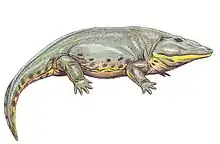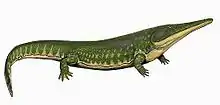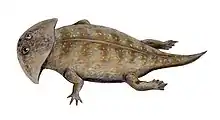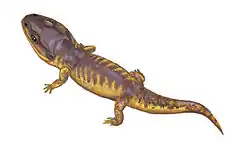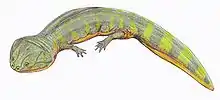Parioxys
Parioxys is an extinct genus of temnospondyl amphibian from the Early Permian of Texas.
| Parioxys Temporal range: Early Permian | |
|---|---|
| Scientific classification | |
| Kingdom: | Animalia |
| Phylum: | Chordata |
| Order: | †Temnospondyli |
| Family: | †Parioxyidae Moustafa, 1955 |
| Genus: | †Parioxys Cope, 1878 |
| Species | |
History of study
The type species, Parioxys ferricolus, was named in 1878 by American paleontologist Edward Drinker Cope based on two badly preserved skulls that were collected from the early Permian Texas red-beds.[1] Egyptian paleontologist, Youssef S. Moustafa, described new material of P. ferricolus from other localities in Texas.[2][3] Moustafa also described another species, P. romeri, on the basis of an isolated humerus, but this was regarded as being indeterminate. A second definitive species, P. bolli, was described by Canadian paleontologist Robert Carroll in 1964.[4] This taxon is only known from postcranial material.
Relationships
Parioxys was historically considered to be closely related to eryopoids, more specifically the well-known Eryops megalocephalus, which was collected from the same locality as the type material of P. ferricolus. Cope himself listed P. ferricolus as a species of Eryops,[5][6] possibly because he considered it to be a juvenile specimen of Eryops.[7] It was shortly revived as a distinct genus[8] with a suggestion that the original specimen's described by Cope might have been inadvertently described as other taxa by other authors,[9] but its affinities continued to be debated, with some suggestions that it might instead belong to the Trematopidae.[10][11] Moustafa (1955a) placed Parioxys in its own family and suggested that it was related to the Dissorophidae.[3] Schoch & Milner (2014) placed Parioxys within Dissorophidae based on personal observations of further preparation of historic material, although this has not been tested in a phylogenetic analysis due to the poor quality of much of the material.[12]
References
- Cope, E. D. (1878). "Descriptions of Extinct Batrachia and Reptilia from the Permian Formation of Texas". Proceedings of the American Philosophical Society. 17 (101): 505–530. ISSN 0003-049X. JSTOR 982652.
- Moustafa, Y.S. (1955). "The affinities of Parioxys ferricolus and the phylogeny of the 'eryopsoid'amphibians". Bulletin de l'Institut d'Égypte. 36: 77–104.
- Moustafa, Y.S. (1955). "The skeletal structure of Parioxys ferricolus, Cope". Bulletin de l'Institut d'Égypte. 1: 41–76.
- Carroll, Robert L. (1964). "The relationships of the rhachitomous amphibian Parioxys". American Museum Novitates. 2167: 1–11.
- Cope, E. D. (1882). "Synopsis of the Vertebrata of the Puerco Eocene epoch". Proceedings of the American Philosophical Society. 20 (112): 461–471. ISSN 0003-049X. JSTOR 982693.
- Cope, E. D. (1888). "Systematic Catalogue of the Species of Vertebrata Found in the Beds of the Permian Epoch in North America with Notes and Descriptions". Transactions of the American Philosophical Society. 16 (2): 285–297. doi:10.2307/1005392. ISSN 0065-9746. JSTOR 1005392.
- CASE, E. C. (2016). REVISION OF THE AMPHIBIA AND PISCES OF THE PERMIAN OF NORTH AMERICA : with a description of permian. insects by e. h. sellards, and a discussion of the. FORGOTTEN Books. ISBN 978-1-333-11391-9. OCLC 982773533.
- Mehl, M. G. (1912-09-27). "A Revision of the Amphibia and Pisces of the Permian of North America". Science. 36 (926): 408–409. doi:10.1126/science.36.926.408. ISSN 0036-8075.
- Watson, D. M. S. (1920-01-01). "The Structure, Evolution and Origin of the Amphibia. The "Orders' Rachitomi and Stereospondyli". Philosophical Transactions of the Royal Society B: Biological Sciences. 209 (360–371): 1–73. doi:10.1098/rstb.1920.0001. ISSN 0962-8436.
- Romer, Alfred S. (1936). "Studies on American Permo-Carboniferous tetrapods". Problems of Paleontology, USSR. 1: 85–93.
- Romer, Alfred Sherwood (1947). Review of the labyrinthodontia. OCLC 253748351.
- Schoch, Rainer R.; Milner, Andrew R. (2014). Sues, Hans-Dieter (ed.). Temnospondyli I - Handbook of Paleoherpetology Part 3A2. Stuttgart: Verlag Dr. Friedrich Pfeil. ISBN 9783899371703.



